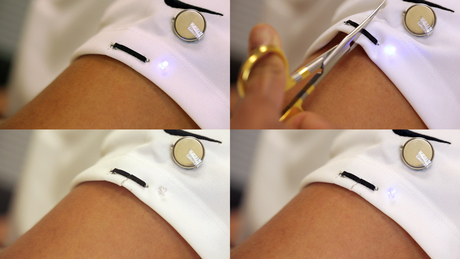Magnetic ink prints self-healing electronics

Engineers from the University of California, San Diego have developed a magnetic ink that can be used to make self-healing batteries, electrochemical sensors and textile-based electrical circuits.
Unlike existing self-healing materials, which require an external trigger to kickstart the healing process and take anywhere from a few minutes to several days to work, the new system can repair damage within about 50 ms, without any outside catalyst.
As explained in the journal Science Advances, the UC San Diego engineers loaded their ink with microparticles made of a type of magnet commonly used in research and made of a metal called neodymium. Because the particles’ magnetic field is much larger than their individual size, the attraction between the particles causes them to close tears — the key to their self-healing properties.
Unfortunately, the particles have poor electrochemical properties, making them difficult to use in electrochemical devices, such as sensors, on their own. To remedy this problem, the researchers added carbon black to the ink — a material commonly used to make batteries and sensors. They then realised that the microparticles’ magnetic fields, when in their natural configuration, cancelled each other out, which robbed them of their healing properties.
The engineers solved this by printing the ink in the presence of an external magnetic field, which ensured that the particles oriented themselves to behave as a permanent magnet with two opposite poles at the end of each printed device. When the device is cut in two, the two damaged pieces act as different magnets that attract each other and self-heal.
The engineers tested their system by using the ink to print batteries, electrochemical sensors and wearable, textile-based electrical circuits, before cutting them and pulling them apart to create increasingly wide gaps. For example, they printed a self-healing circuit on the sleeve of a T-shirt and connected it with an LED light and a coin battery (pictured). They then cut the circuit and the fabric it was printed on, at which point the LED turned off.
Within a few seconds, the LED started turning back on as the two sides of the circuit came together again and healed themselves, restoring conductivity. This continued to be the case even after repeated, widespread damage, with the devices reliably repairing tears as wide as 3 mm — said to be a record in the field of self-healing systems.
In the future, the engineers envision making different inks with different ingredients for a wide range of applications. In addition, they plan to develop computer simulations to test different self-healing ink recipes in silico before trying them out in the lab.
“Our work holds considerable promise for widespread practical applications for long-lasting printed electronic devices,” said Joseph Wang, director of the Center for Wearable Sensors at UC San Diego.
Avoiding EMC issues: simple tests you can do yourself
This is a brief overview of EMC compliance with some practical tips on not getting caught out.
Electric dump valves help oil and gas company reduce emissions
Oil and gas company Laramie Energy deployed ASCO zero-emissions electric dump valves to comply...
Australia's largest electronics expo returns to Sydney
Electronex, the annual electronics design and assembly expo, will return to Sydney on 19–20...




